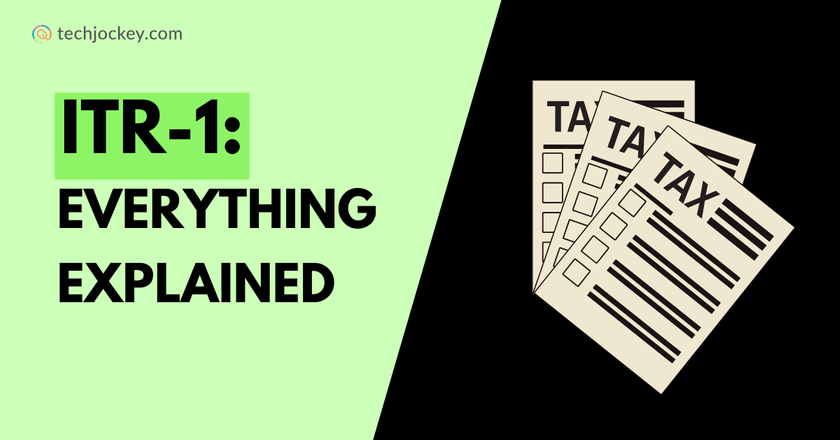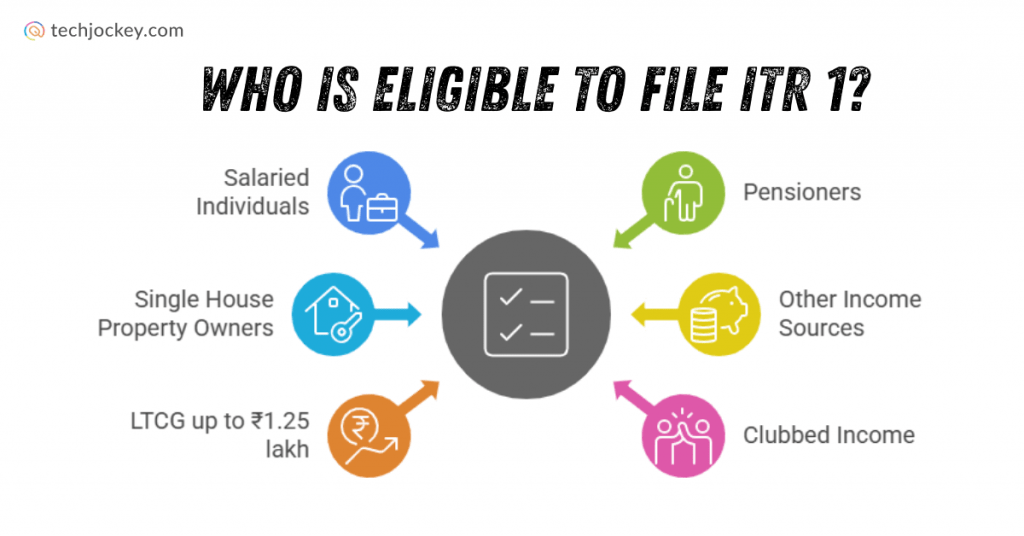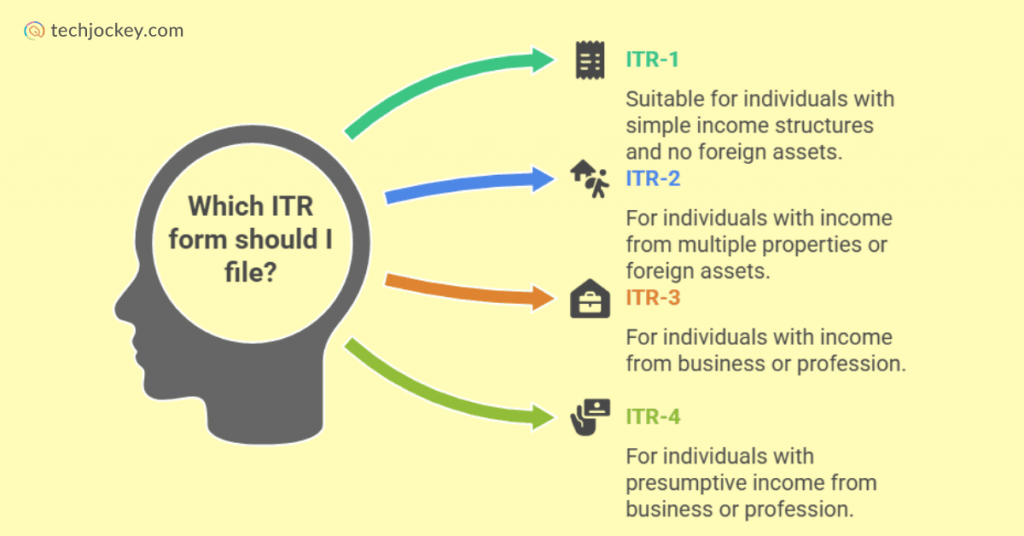ITR-1 (Sahaj Form) – Eligibility, Who Can File & Due Date FY 2024-25

Filing Income Tax Returns (ITR) is important for every individual to keep financial records sorted. It not only has compliance benefits but also helps in applying for loans, visas, or other financial planning.
As not all taxpayers have the same income or source of income, the Government has designed different types of ITR forms.
One such is the ITR-1 form or ITR Sahaj form. It is one of the simplest and most widely used ITR forms. This blog will clear everything about ITR-1: ITR meaning, ITR-1 is for whom, and its filing due date.
Let’s begin.
What is ITR-1 (Sahaj Form)?
ITR-1 is for salaried employees and resident individuals (not an NRI or RNOR) who earn a total income less than or equal to INR 50 lakh. It is also known as the Sahaj Form. This form is specifically made for taxpayers who have limited and straightforward sources of income.
Who is Eligible to File ITR-1?
Eligibility for the ITR-1 form is for everyone mentioned below:
- Any salaried individual or pensioner who has one or multiple employers.
- The one who owns one house property, except where there are losses carried forward.
- Who have other sources of income like bank interest, fixed deposits (FDs), or family pension (Not eligible for lottery or racehorse income).
- Long-term capital gains (LTCG) up to ₹1.25 lakh, as long as there are no carry-forward losses.
- If your spouse’s or minor child’s income is clubbed with yours, but only if the income falls under the above categories.
In short, ITR-1 is ideal for individuals who do not have complicated income structures.
Fun fact: The word Sahaj in Hindi means simple – true to its name, this form makes tax filing quick and easy for eligible taxpayers.

Who Can not File ITR-1?
As every form is designed for different taxpayers, not everyone can file ITR-1. The following are not included in the ITR-1 eligible individuals.

- If your income is above INR 50 lakh.
- A director in a company or ones who hold unlisted equity shares at any time during the year.
- Non-residents (NRIs) and Residents Not Ordinarily Resident (RNOR) cannot use this form.
- If you own and earn income from more than one house property.
- Anyone who earns from a business, profession, or freelancing cannot use ITR 1.
- If your agricultural income is more than INR 5,000.
- If you have taxable short-term or long-term capital gains (except LTCG up to ₹1.25 lakh).
- If you own foreign assets, have financial interests in entities outside India, or hold signing authority in any foreign account.
- If you are claiming double taxation relief under section 90/90A/91.
- If you have deferred tax income from ESOPs of eligible start-ups.
- If you earned income from Virtual Digital Assets like cryptocurrencies or NFTs.
- If there are any special TDS deduction cases, like tax was deducted under section 194N (cash withdrawals over certain limits).
- If you earned money through lottery, racehorses, or other legal gambling activities.
It is important to note that if your income is diverse, complex, or involves foreign elements, you must opt for other ITR forms such as ITR-2, ITR-3, or ITR-4, depending on your case.
Suggested Read: Breaking Down the New Rules for Income Tax in India
Last Date to File ITR-1 for FY 2024-25
The last date to file ITR-1 for the financial year 2024-2025 is 15 September 2025. Earlier, the due date was 31 July 2025, but the date was extended as there were some major changes in ITR-1 done by the government.
What’s good is that you can file a belated return before 31 December 2025 in case you miss the deadline. But, you have to pay late fees and interest under section 234F.
Thus, it is best to file your ITR before the due date to avoid penalties.
Pro Tip: You can use an income tax software to make the job of filing ITR-1 easy. These third-party tax software simplify calculations, reduce errors, and help you claim maximum deductions.
Suggested Read: Income Tax for Freelancer: Self Employment Tax Benefit & Deduction in India
Final Thoughts
Salaried individuals and pensioners with simple incomes can file their income tax returns through ITR 1 or the Sahaj form.
However, you must closely keep a check on the ITR-1 eligibility criteria before filing. An incorrectly chosen ITR form can render your return invalid.
Here’s the summary:
- ITR 1only to be used if your income is up to INR 50 lakh or is from one house property or other simple sources.
- ITR-1 is not to be used if you have business income, more than one property, foreign property, or crypto gains.
- It is best to file ITR-1 on or prior to 15th September 2025 to avoid a penalty.
By being a responsible taxpayer and filing your return on time, you not only perform your duty as a taxpayer but also benefit from easy loans, quick refunds, and peace of mind.
FAQs on ITR-1
What are the types of income that shall not form part of ITR-1 form?
Any capital gains, earnings from a business or profession, or income from multiple house properties and lottery are not part of the ITR-1 form.
Can NRIs file ITR-1?
No, ITR-1 is only for residents of India.
What is the salary limit for ITR-1?
The salary limit for the ITR-1 form is up to INR 50 Lakh, which includes salary, one house property, and other sources except lottery or horse races.
If I am a joint owner of a house property, can I file ITR-1?
No, joint owners of any house property cannot file ITR-1; they must use ITR-2 or any other related form.
Should salaried employees file ITR-1?
Yes, salaried employees with income up to INR 50 lakh should file ITR-1.
How do I know if I have ITR-1 or ITR-2?
If you earn only from one salary, have one house property, and earn within the limit of INR 50 lakh, then you have to file ITR-1; otherwise, go for ITR-2.
Is ITR-1 or 4 for salaried employees?
ITR-1 is for salaried employees; ITR-4 is mainly for individuals with presumptive business or professional income.
Mehlika Bathla is a passionate content writer who turns complex tech ideas into simple words. For over 4 years in the tech industry, she has crafted helpful content like technical documentation, user guides, UX content, website content, social media copies, and SEO-driven blogs. She is highly skilled in... Read more








